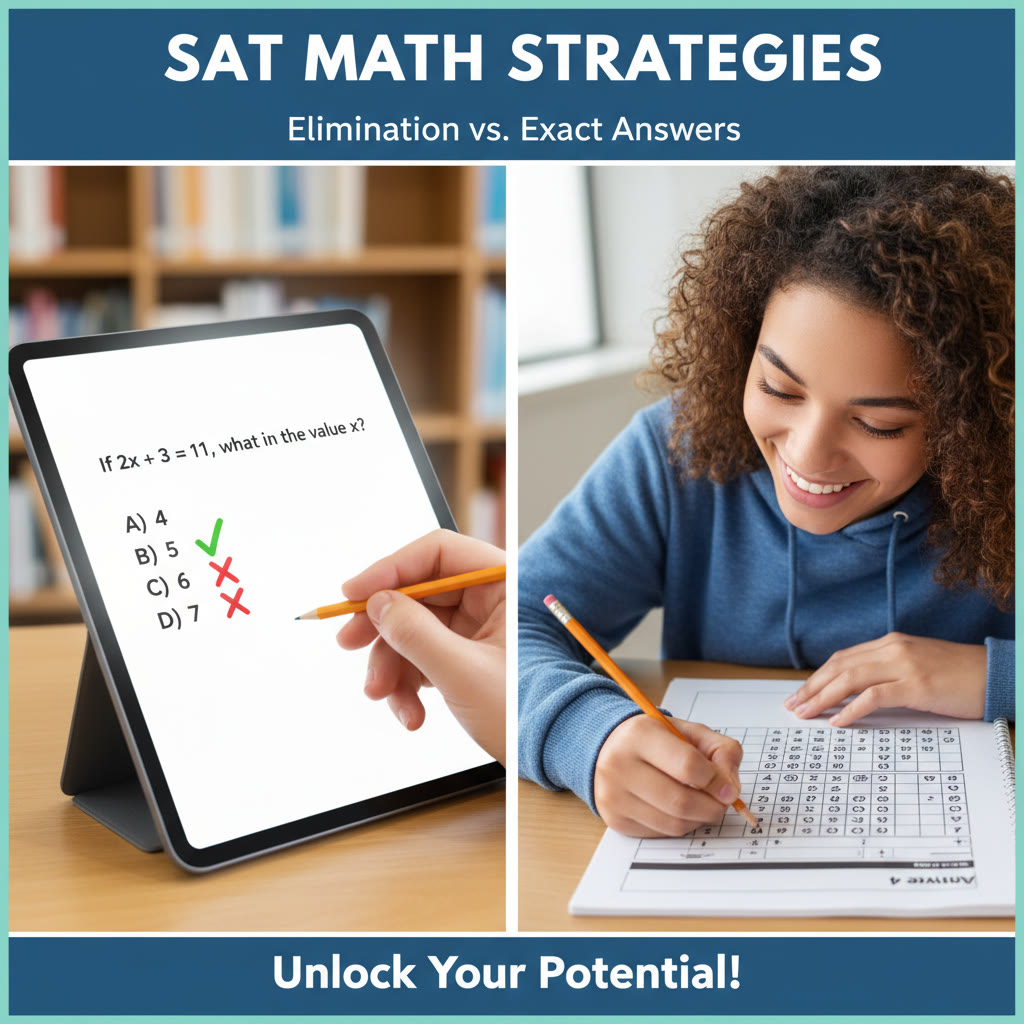SAT Math Face-Off: Problem-Solving vs. Grid-In Questions
If you are prepping for the SAT, you already know math can feel like a series of tiny battles: algebra skirmishes, geometry showdowns, and timing wars. Two of the most important types of encounters you’ll have are traditional problem-solving questions (the multiple-choice items that dominate the Math section) and student-produced response questions, often called grid-in or free response items. Even though the SAT is primarily multiple-choice, understanding the mindset behind grid-in questions is invaluable. Many practice materials, diagnostic tests, and other standardized exams use grid-ins, and the thinking skills required translate directly to higher SAT math performance.
Why this comparison matters
On the surface, a multiple-choice question with four options looks easier: you can guess, eliminate, or backsolve. A grid-in, on the other hand, demands you produce an exact answer — no options, no lifelines. That forces precision. Comparing the two reveals not just different tactics, but different habits of mind: one rewards efficient elimination and estimation, the other rewards accuracy and error-proofing. A student who masters both will be faster, leaner, and far less likely to be tripped up by a cleverly written problem.
What to expect on SAT Math
Quick facts to keep in your mental toolbox:
- The SAT Math section contains 58 questions total and is split into two portions: a No-Calculator section and a Calculator-allowed section.
- Timing is 25 minutes for the No-Calculator portion (20 questions) and 55 minutes for the Calculator portion (38 questions), for a total of 80 minutes.
- Most questions are multiple-choice, but the skills behind student-produced answers (precision, algebraic manipulation, unit checking) are central to success on the SAT.
- There is no penalty for guessing, so educated elimination and smart guessing can help on multiple-choice items.
Quick note about “grid-in” language
Some tests (and many practice resources) use the term grid-in or student-produced response to describe items where you fill in digits or write an exact numeric answer instead of choosing from options. While the official SAT math sections are dominated by multiple-choice items, you should still practice grid-in-type questions because they sharpen the exactness and algebra skills that reduce careless errors across all math items.
Head-to-head: Problem-Solving vs Grid-In
Here’s a compact, practical comparison you can return to when you plan study sessions.
| Feature | Problem-Solving (Multiple-Choice) | Grid-In (Student-Produced Response) |
|---|---|---|
| Answer format | Choose one of four options | Write/enter the numeric answer yourself |
| Guessing | No penalty; educated guess by elimination worthwhile | No penalty; pure guessing harder without options |
| What it tests most | Strategy, estimation, elimination, test-wise techniques | Precision, algebraic manipulation, unit-checking |
| Common pitfalls | Falling for distractors, misreading wording, sloppy elimination | Rounding errors, format mistakes (fractions vs decimals), arithmetic slips |
| Best study focus | Backsolving, plug-in numbers, elimination, timing drills | Set-up accuracy, symbolic solving, exact arithmetic, practice writing answers |
Short takeaway
Multiple-choice is about smart shortcuts and risk management; grid-ins require careful paths to exact answers. Practicing both kinds of thinking makes you a more flexible test taker.
Concrete strategies for multiple-choice problem-solving
These are the tactics that save time and points when you’re facing a traditional SAT math question.
- Backsolve when algebra looks messy — plug answer choices into the equation to see which one fits. This is often faster than symbolically solving.
- Plug in convenient numbers — if a problem contains a variable that stands for an unknown integer or ratio, choose a simple value and carry it through. It transforms abstract problems into number-crunching operations.
- Eliminate ridiculous choices fast — extremes and sign errors are common. If an answer is physically impossible (negative length, for example), cross it off immediately.
- Use approximation and estimation — you don’t always need an exact value if you can rule out three of four options.
- Watch language carefully — phrases like “at least,” “at most,” and “increased by” change equations and trap hurried readers.
Example: Backsolving in action
Problem: A rectangle’s area is 75 and its width is 3/5 of its length. What is the length? Choices: 12, 15, 18, 25.
Tactic: Instead of messy algebra, test options. Suppose length = 15 (choice B). Then width = 3/5 of 15 = 9. Area = 15 * 9 = 135, too big. Try 12: width = 3/5 * 12 = 7.2, area = 86.4, too big. Try 18: width = 10.8, area = 194.4, too big. Try 25: width = 15, area = 375. Hmm none match 75, so we made a mistake reading options — the problem likely expects a smaller length. At this point algebra is simpler: let length = L, width = 3/5 L. Then area = L*(3/5 L) = 3/5 L^2 = 75, so L^2 = 125, L = sqrt(125) = 5*sqrt(5) ~ 11.18. The closest option would be 12 if choices demanded rounding; otherwise none of the provided choices fit. The exercise shows backsolving helps but you must ensure choices are consistent with the algebraic model.
Concrete strategies for grid-in questions
Grid-ins demand clean arithmetic and an eye for format. Here’s how to reduce errors and improve reliability.
- Write clear intermediate work — because there are no answer choices to catch you, your scratch work must be organized so you can trace errors if your answer looks wrong.
- Use exact forms wherever possible — fractions, radicals, and integer answers are often safer than decimal approximations unless the problem explicitly wants a decimal.
- Be careful with formatting rules on test day — if you must enter answers into a grid, know how to format repeating decimals or mixed numbers. On the SAT, formatting expectations in practice materials vary, so practice reproducing the answer format exactly.
- Double-check units and signs — negative signs, units like hours vs minutes, and scaling factors make or break a grid-in response.
- Use the calculator smartly — for grid-ins you need exact answers, but calculators help compute intermediate steps; avoid storing many chained operations that invite rounding drift.
Grid-in example walkthrough
Problem: A tank is 3/4 full with water. After removing 6 liters, it is 2/3 full. What is the capacity of the tank in liters? (Produce an exact numeric answer.)
Solution path: Let capacity = C liters. 3/4 C – 6 = 2/3 C. Solve for C.
- Start: 3/4 C – 6 = 2/3 C
- Bring variables together: 3/4 C – 2/3 C = 6
- Find common denominator: (9/12 – 8/12) C = 6 => (1/12) C = 6
- So C = 6 * 12 = 72 liters
Grid-in answer: 72. Notice the path is straightforward and requires exact fraction arithmetic; a careless decimal or rounding would complicate matters.
When to switch tactics mid-question
Good test takers are flexible. Start with the fastest sensible approach: estimation, elimination, backsolving, or algebra. If the chosen method makes the arithmetic messy and time-consuming, pivot. For example, if backsolving gives you near-miss values and the algebra is manageable, stop the guessing and solve symbolically.
Signs you should switch
- You’ve spent too long testing answer choices without narrowing them down.
- The algebra looks cleaner than repeated numeric trials.
- Your calculator results keep producing decimals when an exact rational form is likely.
Common traps and how to avoid them
Every SAT veteran has a list of favorite traps. Make these habits:
- Read the question twice — first for context, second to map variables and units.
- Underline what is asked — this helps prevent solving for the wrong quantity.
- Estimate before calculating — a quick sense-check prevents obvious mismatches (e.g., answers orders of magnitude wrong).
- Check special cases — plug in zero, one, or negatives when variables could accept them; this often reveals domain restrictions or simplifications.
- Reconcile the units — hours vs minutes vs seconds, dollars vs cents, centimeters vs meters — unit errors are common on grid-ins.
Practice schedule to conquer both styles
Here’s a focused four-week plan you can adapt depending on how many weeks you have left before test day.
- Week 1: Foundations — Refresh algebra, fractions, exponents, and linear equations. Do timed sets of multiple-choice problems to rebuild speed.
- Week 2: Precision drills — Introduce grid-in practice. Focus on exact arithmetic, fraction manipulation, and answer formatting. Aim for accuracy over speed.
- Week 3: Mixed practice — Mix timed problem-solving sets with grid-ins. Simulate test sections and practice switching tactics mid-question.
- Week 4: Mastery and test habits — Full-length practice tests, review every mistake in depth, and practice the final checklist for test day.
How to structure daily study blocks
- Warm-up: 15 minutes of targeted concept review (fractions, algebra rules).
- Practice set: 40 minutes of mixed multiple-choice and grid-ins with a timer.
- Review: 25 minutes of error analysis and reworking incorrect problems.
- Reflection: 10 minutes logging patterns (e.g., careless arithmetic, misread questions).
How personalized tutoring can accelerate progress
Practicing on your own gets you part of the way, but targeted feedback multiplies returns. That’s where one-on-one help becomes a game-changer. A skilled tutor identifies the difference between a conceptual gap and a test-taking habit issue. For example, are you making algebra errors, or are you rushing because you’re not confident? Sparkl’s personalized tutoring offers 1-on-1 guidance, tailored study plans, expert tutors, and AI-driven insights that target your weakest question types, whether multiple-choice problem-solving or student-produced responses. The result: fewer repeated mistakes and smarter practice time.
What to expect from a tutoring session
- A quick diagnostic to find the highest-impact mistakes.
- A tailored plan focusing on the techniques you need most (backsolving, exact arithmetic, formatting answers).
- Timely feedback and practice that adapts as you improve, often driven by smart insights from AI-assisted review.
Test-day checklist for math confidence
- Bring two sharpened pencils, an approved calculator with fresh batteries, and your photo ID if required.
- Start the section by quickly scanning all questions to earmark easy wins versus time-consuming problems.
- Don’t spend more than 1.5 minutes on early multiple-choice questions if you can’t make progress; mark and return.
- For any student-produced item you attempt, write your answer clearly and, if possible, derive it in two quick ways (arithmetic and a reasonability check) before filling it in.
- Use remaining minutes to revisit flagged questions and sanity-check grid-ins for format and sign errors.
Final pep talk: blend the quick and the careful
The real advantage on SAT math isn’t some magic trick. It’s the ability to move between speed and precision: to eliminate and estimate when time is tight, and to slow down and be exact when the problem demands it. Practicing both problem-solving strategies and student-produced response techniques creates mental muscle memory that keeps you alert, flexible, and resilient during the test.
And when you want to compress months of progress into a few focused weeks, consider adding targeted 1-on-1 sessions to your routine. Sparkl’s personalized tutoring can help by creating a study plan that targets your weaknesses, offering expert tutors who teach the right habits, and applying AI-driven insights to keep your practice efficient.


One last practical exercise
Try this short mini-quiz during a timed 10-minute block to test your switching skills. After you finish, review errors and note whether they were conceptual or procedural.
- Item 1 (multiple-choice): A sequence starts 2, 6, 18, 54… What is the 6th term? (Options: 486, 1458, 2916, 8748)
- Item 2 (grid-in): If 2x + 3 = 19, what is x?
- Item 3 (multiple-choice): If f(x) = x^2 – 4x + 3, which of the following is a factor? (Options: x-1, x+1, x-3, x+3)
- Item 4 (grid-in): A number increased by 40% equals 49. What is the original number? (Provide an exact numeric answer.)
Answers to check yourself: Item 1 is 1458 (multiplying by 3 each term); Item 2 is 8 (2x = 16, x = 8); Item 3 is x-1 and x-3 are factors, but only one will be an answer choice — select x-1 if present (plugging in x=1 yields 0); Item 4: original = 49 / 1.4 = 35.
Wrap-up
Whether you encounter a multiple-choice puzzle or a grid-in precision problem, adopt the right habit: if speed will get you to a reliable elimination, do it; if precision is necessary, slow down and solve cleanly. Keep a study rhythm that alternates timed practice and careful review, and get targeted feedback when a stubborn issue persists. With steady practice and a mix of smart tactics, you’ll walk into test day calm, adaptable, and ready to score.
Good luck — and remember: the SAT rewards thinking, not guessing. Train your thinking, and the rest follows.











No Comments
Leave a comment Cancel